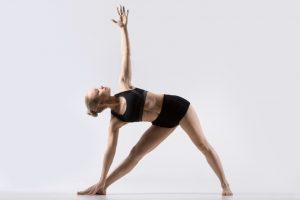Last Updated on | RD, Payal Banka (Registered Dietitian) Leave a Comment
Yoga for psoriasis can help in the treatment plan by reducing stress, promoting relaxation, improving circulation as well as alleviating inflammation. Psoriasis is often triggered by stress. Stress can worsen the skin’s condition. Yoga’s focus on mindfulness and breathwork can help manage stress levels and support overall skin health. While yoga cannot cure psoriasis, it may help manage flare-ups and improve overall well-being.

Benefits of Yoga for Psoriasis
- Stress Reduction: Chronic stress is a known trigger for psoriasis flare-ups. Yoga can help improve the body’s ability to handle stress by lowering cortisol levels.
- Improvement in Blood Circulation: Most yoga poses promote better circulation of blood. This can help by reducing skin inflammation as well as by supporting the healing process.
- Improves Flexibility and Movement: In some severe cases, psoriasis can cause joint pain and stiffness (psoriatic arthritis). Yoga poses can improve joint mobility and flexibility, and also reduce discomfort during body movements.
- Mind-Body Connection: Yoga not only encourages mindfulness and body awareness but also helps in identifying the triggers.
- Boosts Immunity: The calming effect of yoga can help balance the immune system. This is beneficial for managing autoimmune conditions like psoriasis.
Yoga Poses for Psoriasis Relief
1.Trikonasana (Triangle Pose)

- How to Do It: Stand with your feet wide apart. Extend your arms out to the sides, and reach one hand down toward your ankle, shin, or floor while the other arm extends upward. Keep your body in a straight line and focus on your breath.
- Benefits: Improves circulation, stretches the body, and promotes overall body balance. It also helps open the chest and reduce stress.
2. Adho Mukha Svanasana (Downward-Facing Dog)

- How to Do It: Start in a plank position with your hands and feet shoulder-width apart. Lift your hips toward the ceiling, forming an inverted V-shape with your body. Keep your head between your arms and let your heels gently press toward the floor.
- Benefits: Strengthens the body, improves circulation, and relieves tension in the back and shoulders. Also helps reduce stress.
3. Setu Bandhasana (Bridge Pose)

- How to Do It: Lie on your back with your knees bent and feet flat on the floor, hip-width apart. Press your feet into the ground, lift your hips toward the ceiling, and clasp your hands under your back.
- Benefits: Opens up the chest, relieves stress, and improves blood circulation. Also strengthens the lower back and hips.
4. Viparita Karani (Legs Up the Wall Pose)

- How to Do It: Sit next to a wall and lie on your back. Extend your legs up the wall and keep your arms relaxed at your sides, palms facing up. Close your eyes and focus on your breath.
- Benefits: Promotes relaxation, reduces stress, and enhances circulation to the legs and feet. Helps to calm the nervous system.
5. Matsyasana (Fish Pose)

- How to Do It: Lie on your back and lift your chest, arching your back while supporting your body weight on your elbows. Allow the crown of your head to gently rest on the floor behind you.(Abov image is for reference only)
- Benefits: Expands the chest and throat, promotes relaxation, and increases blood flow to the neck and spine.
6. Balasana (Child’s Pose)

- How to Do It: Start in a kneeling position, then sit back onto your heels and stretch your arms forward on the mat. Rest your forehead on the floor and focus on deep, relaxing breaths.
- Benefits: Calms the mind, reduces stress, and relieves tension in the back, neck, and shoulders. Great for stress relief.
7. Baddha Konasana (Bound Angle Pose)

- How to Do It: Sit with your spine straight and bring the soles of your feet together. Let your knees drop out to the sides. You can hold your feet with your hands or place your hands on your feet with your elbows gently pressing your thighs down.
- Benefits: Opens the hips, stretches the groin, and promotes relaxation.
8. Sukhasana (Easy Pose) with Deep Breathing

- How to Do It: Sit on the floor with your legs crossed, ensuring your back is straight and shoulders relaxed. Rest your hands on your knees, palms facing up, and close your eyes. Focus on deep breathing (inhale through your nose, exhale through your mouth).
- Benefits: Helps calm the nervous system, reduce stress, and promote mindfulness.
9. Nadi Shodhana (Alternate Nostril Breathing)

- How to Do It: Sit comfortably in a cross-legged position. Close your right nostril with your thumb and inhale deeply through the left nostril. Close the left nostril with your ring finger and exhale through the right nostril. Repeat, alternating nostrils.
- Benefits: Calms the mind, reduces stress, and balances the nervous system. Great for relaxation and mindfulness.
10. Pranayama (Breathwork)

- How to Do It: Sit in a comfortable position with your spine straight. Practice slow, deep breathing (inhale for a count of four, hold for a count of four, exhale for a count of six). Focus on your breath and try to empty your mind.
- Benefits: Reduces stress, calms the nervous system, and improves oxygen flow to the body. Regular pranayama can be an effective tool for stress management and inflammation reduction.
Tips to Maximize the Benefits of Yoga for Psoriasis
Aim to practice yoga regularly, ideally 4-5 times a week. A minimum 20-25 minutes session can be beneficial for reducing stress and improving circulation.
As any other activity, it is best to do yoga under a trained professional. If you feel any joint pain or discomfort from psoriasis, avoid poses that put too much strain on your joints. Convey your discomfort to the instructer, who will modify poses to suit your comfort level.
Yoga is not only about physical movement but also about creating a deep connection between body and mind. It is important to focus on your breath throughout your yoga session. If you do the poses with regulated breath in’s and breathe out’s, you can avail maximum benefit. This connection can help reduce stress, a major trigger for psoriasis flare-ups.
Drink plenty of water before and after your yoga session to stay hydrated and support skin health. You can also include infused water , buttermilk, coconut water and other stress relieving fluids.
A Diet that suits your lifestyle and also helps in reducing the inflammation can help you tremendously. Anti inflammatory diets seems to work in the best way to provide relief in psoriasis. Check this indian diet plan for psoriasis. You can reach out to us at [email protected] to avail a personalized diet tp suit your requirements and medicines. We can also provide you a diet based on your ayurvedic prakriti to balance your doshas and help you feel better in your body.
End Note
Yoga can be a great addition to your routine if you’re dealing with psoriasis. It offers a holistic approach by addressing both the physical and emotional aspects of the condition. By combining yoga with a healthy lifestyle, proper skincare, and medical treatment, you can help manage your psoriasis more effectively. Always consult with your healthcare provider before starting any new exercise routine, especially if you have joint issues or other health concerns.
About RD, Payal Banka (Registered Dietitian)
RD, Payal Banka (Registered Dietitian)
Payal(पायल) is a Registered Dietitian with 15 years of experience. She is a Professional Blogger, Author, and a Youtuber. She is an MBA in Health care and Hospital management. Payal believes in healthy living. Here at Dietburrp, you will find her talking about health, weight loss, fitness, parenting, healthy cooking and how to keep yourself motivated to be healthy.

 Indian Diet Plan for Multiple Sclerosis PDF
Indian Diet Plan for Multiple Sclerosis PDF


